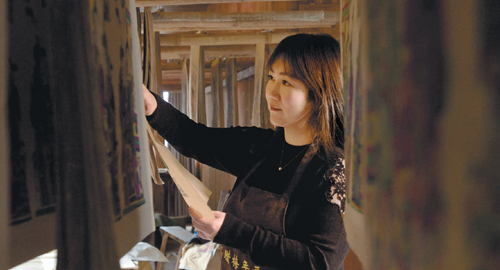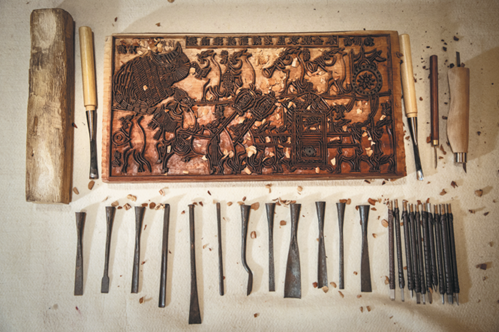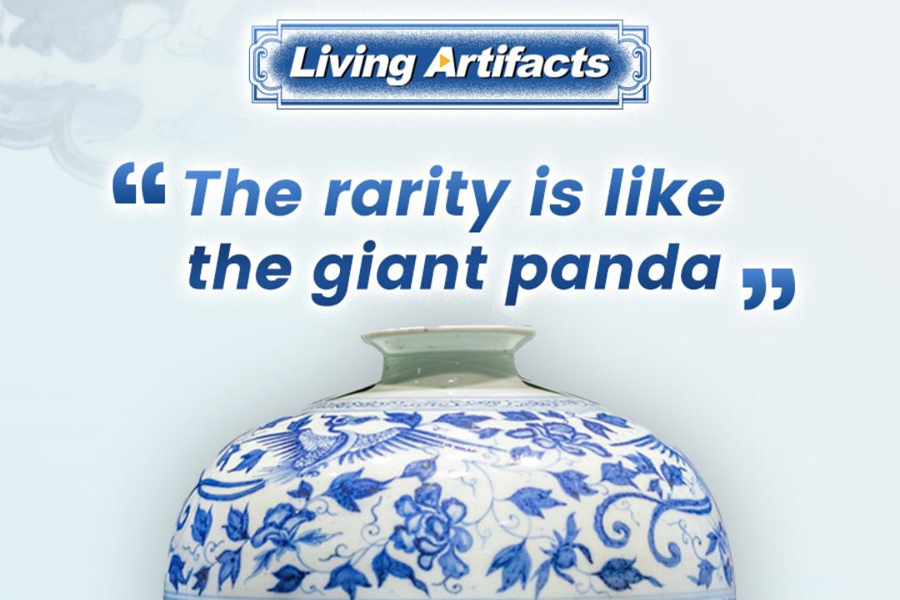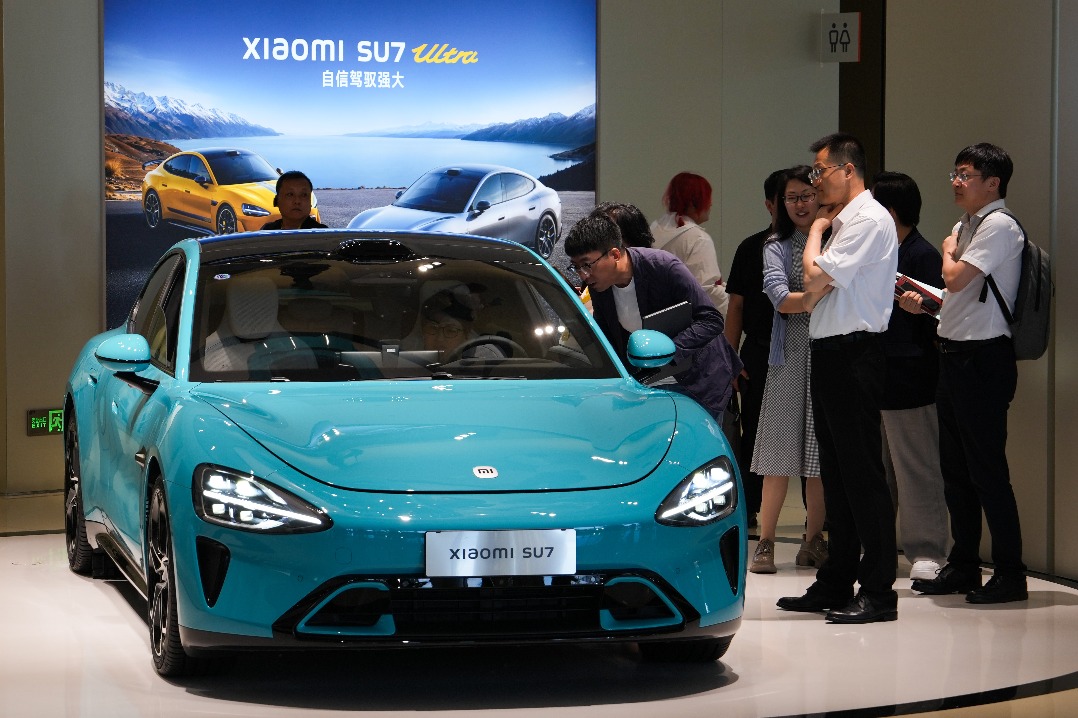CALL OF A CRAFT
Tantou-style pictures provide a flavor of Chinese New Year and carry the historical memory of the town where they are made, Yang Feiyue reports.

A fresh scent of soil wafts in the air around the Gaolamei workshop in early March. Rows of wet paper made from bamboo hang on a thread and glitter with a tint of yellow under the light at the facility located in Tantou town, Longhui county, Central China's Hunan province.
At a long table there, a young woman is busy with Tantou-style New Year pictures, a folk craft that has been carried forward by Zhong Xinglin's family for four generations.
She has been working on a series of rabbit figures following the style that can be traced to the late Ming Dynasty (1368-1644). As part of traditional Chinese culture, Tantou-style New Year pictures feature auspicious figures and elements from folklore that carry people's prayers for good fortune, guardianship and prosperity in a new year.
In the early 1900s, this form of woodblock-printed New Year pictures entered a golden age, not only making its way across the country but also being exported to more than 10 countries and regions in Southeast Asia.
As China continues to step up efforts to preserve intangible cultural heritage, more people from the younger generations are turning their attention to traditional art and crafts.
Zhong is one of them.
"We received many requests for rabbit-themed paintings in this Year of the Rabbit," says the woman in her early 30s, adding that she was swamped with orders for such pictures before Spring Festival in January.
"People hotly sought the paintings as holiday gifts for their families and friends," Zhong says.
Since the holiday passed, Zhong has been able to get breathing space, but she remains busy participating in various cultural exhibitions and preparing for an increasing number of visitors coming her way to appreciate the folk craft, which was named a national intangible cultural heritage in 2006.
Inheritors' family
To make Tantou-style New Year pictures, some 20 steps are followed, including using pear wood for engraving and bamboo to make paper, as well as multiple uses of woodwork and hand-painting before vivid, colorful folk paintings are produced by the skillful hands of artisans.
Zhong's interest in this craft stemmed from the influence of her family.
Her grandparents were all national-level inheritors, and her father won the title in 2018. Their century-old family workshop is named after Zhong's grandmother Gao Lamei.
"My childhood memories mostly revolve around the workshop, where I watched them (grandparents and parents) making the New Year pictures," she says, adding that she then spent time learning the craft and played with the tools lying around.
"The engraved pear wood for printing, various pigments, and the stories behind each picture still often come into my mind," she says.
In 2011, Zhong landed a job at a local news agency in Changsha, the provincial capital of Hunan, after completing her Japanese-language studies at Guizhou Normal University in southwestern China.
"I got exposure to various cultural development models and discovered the charm of traditional culture," Zhong says.
After her grandparents passed away, she says, she felt a great sense of responsibility to carry on with the family's work.
In 2017, she quit her job and learned more about the New Year pictures from her father.
Local materials
It takes about six months, from creating a new design to delivering a Tantou-style New Year picture. All materials and processes used in the production are localized in Hunan. The paper and pigments used are made of the moso bamboo that is native to China.
"The raw paper is thick and strong, with a creamy yellow color," Zhong says.
Before printing, the paper needs to be steamed to increase its toughness and flexibility and is coated with a glue concocted out of a fine, white natural mineral, so that the paper can better take in and show colors with vivid effect.
"After digging up soil from the mountains, we need to crush it with a large and heavy wooden hammer on a workbench, and then put it in a water tank to settle and wash," Zhong explains.
After the paper is processed and air-dried, it is trimmed by hand and prepared for use. Then the image is engraved by hand on woodblocks.
"Each color in a New Year picture requires several color blocks, plus a line block," Zhong adds.
Then the colors are mixed and matched before applying to woodblocks to create a bright, sharply contrasting visual impact that can give people a sense of joy and warmth.
"Light colors are printed first before dark colors, so they blend with one another to create a relief effect," she says.
After the images are printed on paper, they are hung on bamboo poles to be air-dried before the hand-painting begins.
"The facial features of the characters are often hand-drawn, which is called 'facial opening'", Zhong says.
The cheeks and lips are usually painted in red, and a beard is outlined with a wide brush.
"This technique is most typical in the pictures of deities," she says, adding that "facial opening" is a crucial step in the production process and determines if the figures are lifelike.
Zhong says she has noticed the increasing premium put on intangible cultural heritage. "A New Year picture also made its way to the subway in Changsha around Spring Festival."
Folk value
In recent years, Tantou-style New Year pictures have gained attention beyond the country's borders.
Zhong displayed her works in Warsaw in 2018 during an intangible cultural heritage exchange program. Afterward, she traveled to the United Kingdom and the Czech Republic to participate in other cultural exchanges and got a sense of the interest in the pictures overseas.
"Foreign friends love this traditional Chinese culture," Zhong says.
"Each time we went abroad for such exchanges and exhibitions, the several large boxes of New Year paintings that we took with us were sold out."
Sun Chan, an official with the Hunan literary and art federation, says red was the most frequently used color in the early stage of the craft's development, which was related to the folk custom of "driving away evil spirits".
"Just like firecrackers and red candles, strong red color also symbolizes good luck and prosperity in local culture," Sun says.
Tantou used to be a small town but has managed to preserve all processes of making such paintings, which is rare, she adds.
"This is also a reason why the pictures have both folk style and value," Sun says.
Although things have changed a lot over the years, the New Year pictures are still a name card for the town and an emotional connection for people from the province.
In her works, Zhong has incorporated elements of Tantou's culture and tourism to appeal to travelers to Hunan. She says the cultural connotations in the pictures enrich travelers' experience.
"We can call on artists in our field to create culture and tourism-themed paintings and collaborate with various cities in hosting festivals and exhibitions to promote the art and let more people learn about Hunan," Zhong says.
She plans to incorporate more local natural landscape and folk stories into the New Year pictures in the future.
Zhong has started Tantou-style New Year picture classes in Changsha to popularize the craft.
"We are booked by visitors, especially for primary school students, for 20 days every month during spring and autumn," she says.
Zhong has worked with local beverage and clothes brands and restaurants, as well as game designers to expand the presence of the pictures in daily life.
"We can explore more possibilities to integrate the craft in modern life, so it can retain vitality and live on."



Today's Top News
- China reaffirms sovereignty over Taiwan, says complete reunification unstoppable
- A-share market surges past 100 trillion yuan milestone
- No reason for Germany to let political expediency hurt relations with China
- Book on Xi's views on strengthening, revitalizing armed forces published
- China supports Ukraine peace talks between all parties
- China to hold press conference on military parade preparations





























